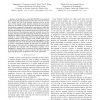Free Online Productivity Tools
i2Speak
i2Symbol
i2OCR
iTex2Img
iWeb2Print
iWeb2Shot
i2Type
iPdf2Split
iPdf2Merge
i2Bopomofo
i2Arabic
i2Style
i2Image
i2PDF
iLatex2Rtf
Sci2ools
GLOBECOM
2008
IEEE
2008
IEEE
Maximizing Transport Capacity for Geographic Transmission on Nakagami-m Channels
—In mobile ad hoc networks (MANETs), conventional packet forwarding schemes that pre-select the next-hop receivers for a packet may fail if the channel coherence time is on the order of the typical packet duration because the pre-selected node may often suffer a deep fade for the duration of the packet. An alternative approach is geographic transmission, in which the packet is transmitted in the direction of the destination, but the next-hop forwarding node is selected among those nodes that are in the direction of the destination and that correctly recover the message. This approach takes advantage of multi-user diversity to significantly improve the probability of the packet being correctly received by a forwarding agent. However, this approach places additional burden on the energies of the mobile nodes if the forwarding scheme requires all of the next-hop neighbors of the transmitter (that are in the direction of the destination) attempt to receive a transmitted message. In this...
GLOBECOM 2008 | Mobile Ad Hoc Networks | Packet Forwarding Schemes | Telecommunications | Typical Packet Duration |
| Added | 29 May 2010 |
| Updated | 29 May 2010 |
| Type | Conference |
| Year | 2008 |
| Where | GLOBECOM |
| Authors | Tathagata D. Goswami, John M. Shea, Tan F. Wong, Murali Rao, Joseph Glover |
Comments (0)

